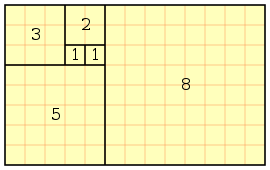Here I have continued the exploration in to a finite set of modules.
The goal is to find a 'smart set' or group of units which 'work well' with each other. I have taken these module units from the Fibonacci sequence as in the previous tests, this time with larger numbers. The qualities I am looking for are the 'flexibility' or ability to form fine graduations in scale.
This combination using
5:8:13:21 appears not to have good flexibility in the initial 10 graduations only 50% of the values can be achieved. However a system that generally uses more than 10 components may not be hindered by this initial small scale short coming. Baring in mind there is no scale set yet so the modules could be meters or millimetres long.
In this ratio there is another short coming I have noticed and left viable in the image.
The value generated by adding 5 and 8 is equal to the next module 13 (because they follow the Fibonacci sequence). The short coming is that the opportunity for a new unit/value from combining two components is wasted as it is the same value as the next size component. this shows an over supply, an excess in the system. This is in itself not a bad thing but when other values are not able to be achieved it is indicating to me that this ratio is not a 'smart set'.
Ideally the aim is flexibility in the dimensions of an assembled group of components.
Also there is the fine adjusting which will be a powerful ability of a modular building system, in order to make fine changes to an assembly one would not want to be removing a 21 unit module and replacing it with four 5unit modules.
The mission for flexibility has failed in many metabolist-esque buildings around the 60's. I believe the problem is in how society is able to control the flexibility, which they must. Defining this flexibility in social terms may be a more appropriate paradigm. The flexibility, physically means the ability to make minute to massive changes with minimal disturbance and do this through time.

 Lego Creator(tm) series provides the user with a set of materials and a set of instructions. With this product the User may follow a choice of three instruction sets, to construct one of the three building designs using the set materials.
Lego Creator(tm) series provides the user with a set of materials and a set of instructions. With this product the User may follow a choice of three instruction sets, to construct one of the three building designs using the set materials.







